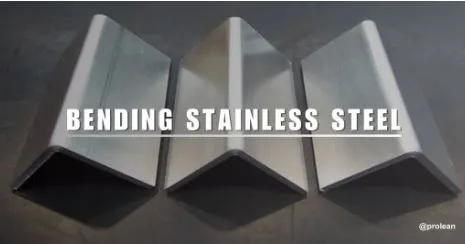Bending Stainless Steel: Challenges & Best Practices
Sheet metal bending is a process of bending metal or metal deformation into desired shapes by applying force, ultimately bending it into specific shapes and required angles. Many businesses prefer stainless steel sheets because they are strong and corrosion-resistant. It is widely used globally in all fields, such as medical equipment, food processing tools, aerospace parts, and buildings. Bending stainless steel, whether in sheets or tubes, is tough. Its strength and stiffness create special challenges. This article explores the challenges, techniques, and best practices in bending stainless steel sheet metal and tubing.
Why Bending Stainless Steel Is Challenging?
Unlike pliable(materials which bend easily), materials like aluminium and stainless steel are much tougher. It is much more rigid and less flexible. This means it is more resistant to your efforts and springs back into its original shape or cracks if not done carefully.
One of the main factors you need to pay attention to before getting the required shape is the material’s thickness. You’ll probably need specialized bending tools to get the job done perfectly. That’s why knowing the right tools and techniques is very important. It helps you avoid mistakes and ensures your final product turns out just how you want.
Understanding Stainless Steel Grades
Not all stainless steel behaves the same when you try to bend it. Things like bend radius, the amount of force required, and even the tooling configuration can vary depending on the type of steel you’re dealing with. The most commonly used grades are 304 and 316 stainless steel.
304 stainless steel
304 is the popular and top priority choice in the metalworking industry. It is flexible, ductile, and corrosion resistant because of its chromium oxide passive layer. That used to make it easier to bend in challenging scenarios. 304 bendability is handy when you need consistent results.
304 Vs. 430 Stainless Steel
316 stainless steel
316 stainless steel has Molybdenum. It can withstand chlorine and harsh chemicals better with this new feature. It prevents corrosion better than 304. However, bending is more challenging. This requires more effectiveness and precision while creating.
Methods of Bending Stainless Steel Sheet Metal
The process of bending stainless steel sheet metal can be done in a few different ways. Let’s dive into the most common methods:
1. Rotary Bending:
A rotary bending machine uses a spinning bending tool, which is most suitable for high-volume production. It allows for creating bends easily, without needing many tooling changes.
Rotary draw benders are popular for making smooth, high-quality bends in stainless steel tubing. These machines use a die to draw the tube around a fixed radius. Secure the tube in the bender, align it with the bending die, and activate the machine. This method creates even bends with little distortion. It’s suitable for both structural uses and decorative projects.
Rotary Draw Bending
2. Compression Bending
A stainless steel tube is clamped around a fixed die that applies pressure and bends it. Although it’s usually a fast operation, it won’t work for curves with short radius.. It’s simple, cost-effective, and has high output. If the bending tube diameter is less than twice the bend’s centreline diameter, it can affect compression bending because it may lead to excessive deformation. The required bend can’t be made with a 1-inch pipe elbow that lacks a 2-inch centerline.
3. Mandrel Bending
A mandrel bender is ideal when bending tubing with a tight radius. This device supports the tube’s interior while bending. It stops flattening and wrinkling. To use a mandrel bender, first insert the mandrel into the tube. Then, align it with the bending die. Finally, apply steady pressure. This method creates a smooth bend without kinks. It’s great for precise tasks, like exhaust systems and medical devices.
4. Three Roll Bending
The machine bends the stainless steel pipe or tube slowly. It applies pressure at specific points with three rollers. Its typical application is for bends with greater radii. Roll bending is a typical manufacturing process for creating spirals. Lifting the tube after each rotation allows operators to develop continuous coils. For this procedure, the workpiece needs a big radius and a pitch of one diameter. A second roll might come in handy when a bigger coil pitch is required. Adding this additional roll to the coiling process helps to expand the tube.
Each method has benefits. These depend on material thickness, bend radius, and production volume. The process can create different shapes, like bends and flanges. These shapes are used in many applications, from car parts to architectural features.
Bending Stainless Steel Tubing: Key Considerations
Pay attention to these key points to bend stainless steel tubing effectively and accurately. The main factors that need attention are:
-
Measuring and Marking
A measuring tape or gauge will identify the bend’s start. Mark this place with a permanent marker or scribe for accuracy. This keeps the tube tightly in the entire structure and saves material.
-
Bend Radius
Bending stainless steel tubing requires special attention to wall thickness and bend radius. Bend radius can make or break your project. If you go too tight, it will result in cracks, kinks, or worse. That’s why it is essential to understand and follow the manufacturer’s guidelines.
-
Tool Selection
Bends will be uniform and precise if you use the correct tools. The diameter and material type of the tubing should be matched with the bender and its attachments. Wrong selection will result in the loss of your efforts.
-
Temperature Control
Along the marked bend line, use the blowtorch to heat the sheet. Heat the sheet uniformly; otherwise, it may lead to spots/scars and create stress points. Temperature monitoring should be done using an infrared thermometer to ensure the sheet metal reaches its optimal temperature, depending on the grade of the stainless steel(usually 600-700°C).
The Role of the Bend Radius
The bend radius plays a critical role in determining the quality of the final bend and structural integrity. Bending with a small radius can lead to cracking. This is especially true for harder stainless steels. A bend radius of 1.5 times the thickness is a good rule for most 304 stainless steel sheets.
A stainless steel bend radius chart helps match the radius to the material’s thickness and grade. Tighter bends require more advanced tooling or annealed materials to reduce risk.
Tips on How to Bend Stainless Steel Successfully
Here are a few key tips on how to bend stainless steel without compromising its properties:
- Pick the proper bender, whether a hydraulic bender, a mandrel bender, a rotary draw bender, or a manual tube bender. Your choice depends on the job and the tubing size.
- Always match the tool with the tube’s diameter—you might need heavy-duty equipment for tubes with greater diameters.
- Using press brakes with precision tooling will give you better control and consistency.
- Pay attention to grain direction—Bending across the grain direction results in smoother results and minimizes the risk of cracks.
- The key is to apply force gradually. This way, it keeps its strength and takes on the desired shape. Sheet metal bending is key for making parts with exact angles and sizes.
Conclusion
Working with stainless steel is not simple, but accurate bends are entirely within reach with some planning and the right tools and techniques. If you’re not confident handling it yourself, there’s no harm in turning to the pros. With the right technique and process,
you can save time, materials, and perform with precision.



